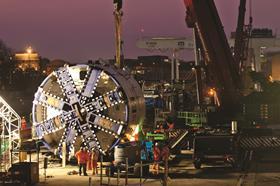New infrastructure work halves, as new orders in the construction industry fall 10%

A decline in infrastructure saw new orders in the construction industry fall 10% in the first three months of 2013 compared with the last three months of 2012.
Figures from the Office for National Statistics showed new orders totalled £10.7bn in the first quarter of 2013, down from £12bn in the fourth quarter of 2012.
This fall was driven by a halving in the level of new infrastructure orders over the period, which fell to £1.6bn.
All other sectors showed positive growth, new housing orders reached their highest level since the first quarter of 2008 at £3.3bn.
The level of new orders was only 0.2% down on the same period last year.
The figures will be a blow to the Chancellor who has announced a variety of boosts for the infrastructure sector in recent years.
In his 2011 autumn statement George Osborne announced that he planned to attract £20bn of private investment into UK infrastructure. Then in July he unveiled the UK Guarantees scheme designed to help realise £40bn of infrastructure projects.
In the budget in April he announced a £3bn boost for infrastructure capital spending, though this is not set to come online until 2015.
Alasdair Reisner, director of external affairs for the Civil Engineering Contractors Association (CECA), said the first quarter of the year was usually a strong one for infrastructure orders so today’s numbers were a “surprise”.
He added: “The government have placed infrastructure at the heart of its growth strategy, and if these figures represent the beginning of a trend in falling orders and activity in the sector, this will put the UK’s economic recovery at risk.”
Noble Francis, economics director at the Construction Products Association, said the infrastructure figures were “disappointing” given the number of announcements on infrastructure spending and support chancellor George Osborne has made in recent years.
“Either it [the infrastructure decline] means the investment has not come through or it’s taking a long time to procure,” he added.
Simon Rawlinson, EC Harris head of strategic research & insight, said the 10% drop in orders was a “shock”. “It will come as a disappointment given a recent improvement in sentiment, and brings to the end a steady increase in volumes seen since mid 2012,” he said.
“The bad news of course is that infrastructure orders halved in the first quarter to the lowest level seen since early 2011.
“Whether this is a harbinder of falling infrastructure volumes or a short term blip, time will tell. What the data does tell us however, is that infrastructure orders are up by 18% in the year - making up for shortfalls elsewhere.
“The disappointment is private housebuilding. Whilst the builders tell us that sales have been up this year, particularly benefitting from the Help to Buy scheme, this hasn’t filtered through to extra orders yet.
“Hopefully the 2nd quarter data will see new starts converting into real income for the industry.
He said the real concern was the commercial sector. “Unfortunately, the commercial sector remains stagnant, and in reality has shrunk by a further 12% during the year in real terms.
“By contrast, orders from the public sector grew by 9% - what does this tell us about private sector confidence?
“A quick look at regional data, which is not adjusted for inflation, shows that there are clear winners and losers - and not just in London and the South East. Wales and Scotland have also seen improvement.
“By contrast the east of the country, stretching from the Midlands right up to the North East are having a particularly tough time.
“Only when there is robust growth across the board can we consider that recovery is really under way. Whilst today’s data is not quite as bad as the headlines might suggest, the detail shows that in key sectors there is a still a long and rocky road.”




























No comments yet